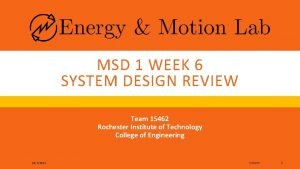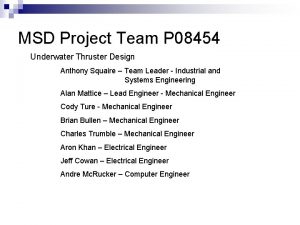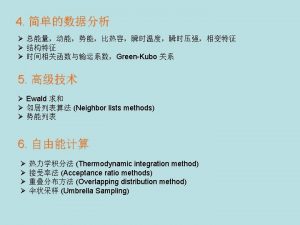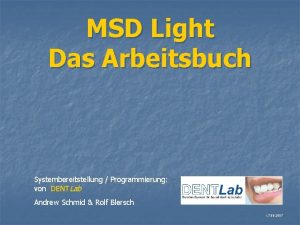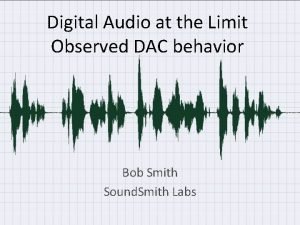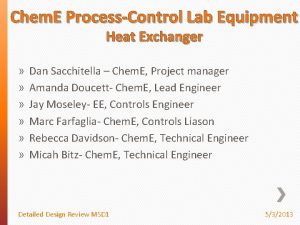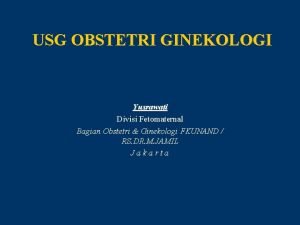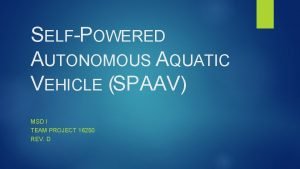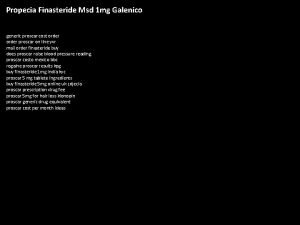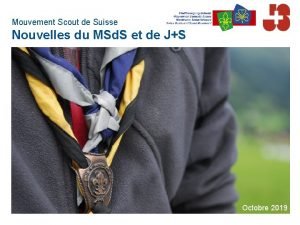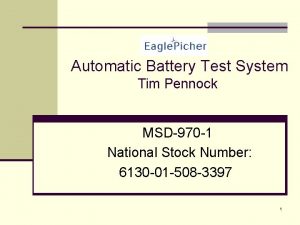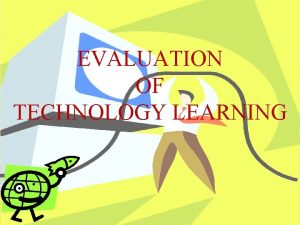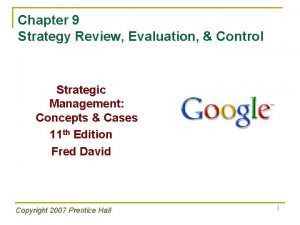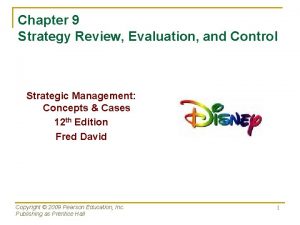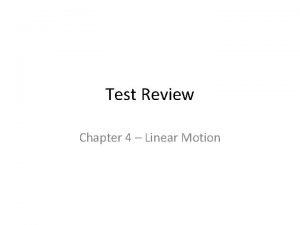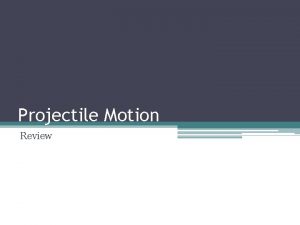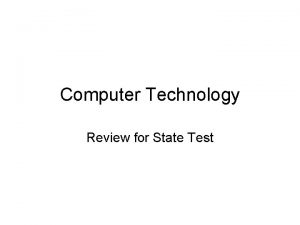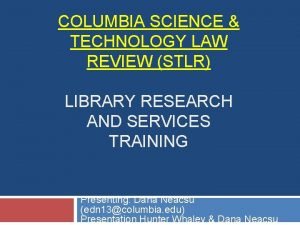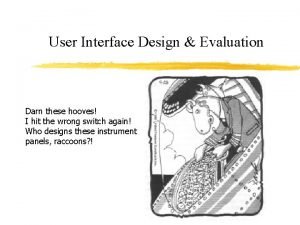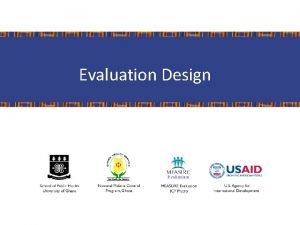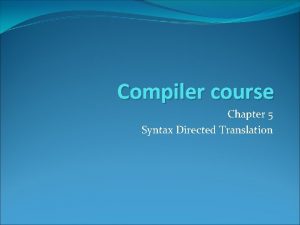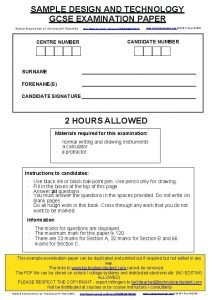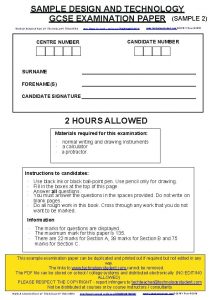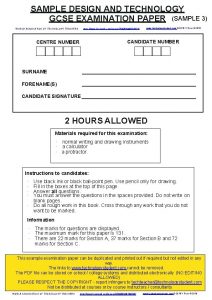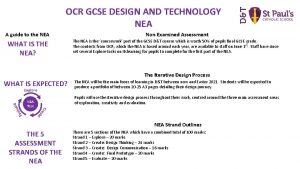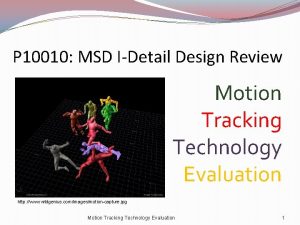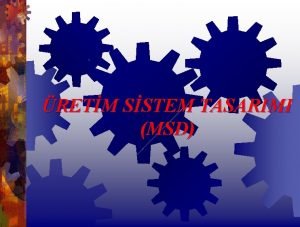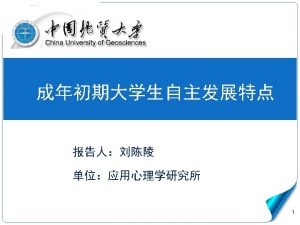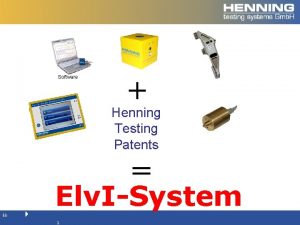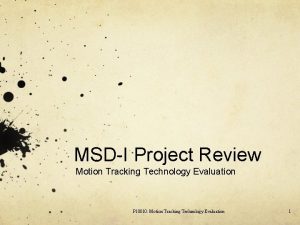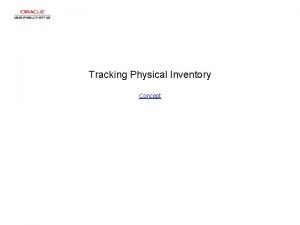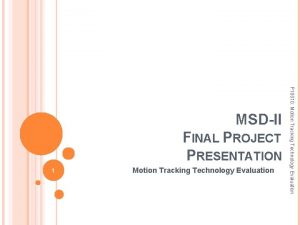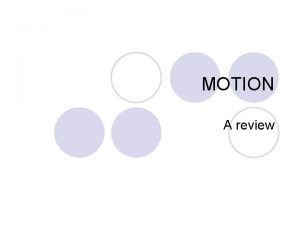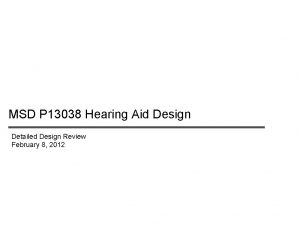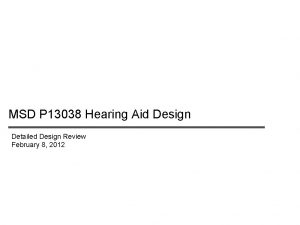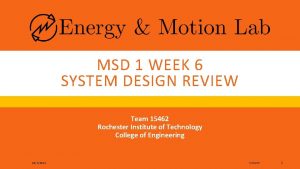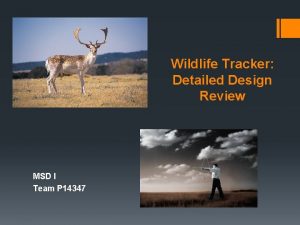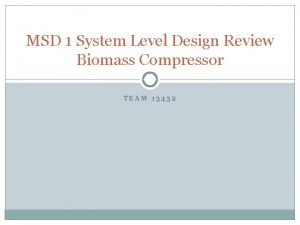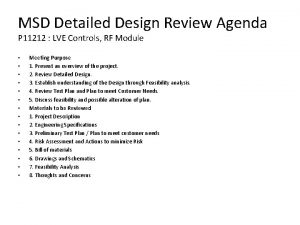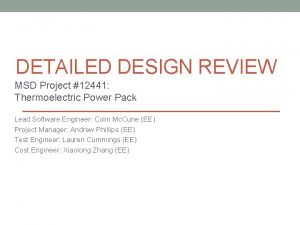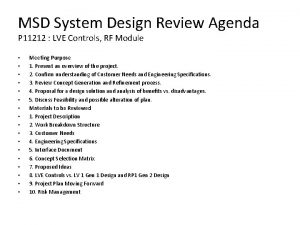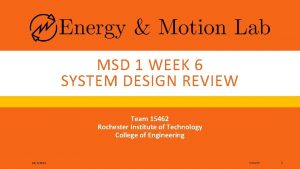MSD ISystem Design Review Motion Tracking Technology Evaluation














![XSENS Mti Sensor [http: //www. xsens. com/images/stories/products/PDF _Brochures/mti%20 leaflet%2009. pdf] - 360 Degree Orientation XSENS Mti Sensor [http: //www. xsens. com/images/stories/products/PDF _Brochures/mti%20 leaflet%2009. pdf] - 360 Degree Orientation](https://slidetodoc.com/presentation_image_h2/4a70231d8b5bed7350ea0faf17fd5863/image-15.jpg)







![Concept R&D – Interface Circuitry [TI App. Note SLOA 058] [The Art of Electronics, Concept R&D – Interface Circuitry [TI App. Note SLOA 058] [The Art of Electronics,](https://slidetodoc.com/presentation_image_h2/4a70231d8b5bed7350ea0faf17fd5863/image-23.jpg)
















![Risk Assessment- Team Dynamics [Refer to: P 10010 PDF, page 18] Motion Tracking Technology Risk Assessment- Team Dynamics [Refer to: P 10010 PDF, page 18] Motion Tracking Technology](https://slidetodoc.com/presentation_image_h2/4a70231d8b5bed7350ea0faf17fd5863/image-40.jpg)
![Risk Assessment- Sensors [Refer to: P 10010 PDF, page 18] Motion Tracking Technology Evaluation Risk Assessment- Sensors [Refer to: P 10010 PDF, page 18] Motion Tracking Technology Evaluation](https://slidetodoc.com/presentation_image_h2/4a70231d8b5bed7350ea0faf17fd5863/image-41.jpg)
![Risk Assessment- MCUs, Data [Refer to: P 10010 PDF, page 19] Motion Tracking Technology Risk Assessment- MCUs, Data [Refer to: P 10010 PDF, page 19] Motion Tracking Technology](https://slidetodoc.com/presentation_image_h2/4a70231d8b5bed7350ea0faf17fd5863/image-42.jpg)
![Risk Assessment- MCUs, Data (cont. d) [Refer to: P 10010 PDF, page 19] Motion Risk Assessment- MCUs, Data (cont. d) [Refer to: P 10010 PDF, page 19] Motion](https://slidetodoc.com/presentation_image_h2/4a70231d8b5bed7350ea0faf17fd5863/image-43.jpg)
![Risk Assessment-Test Methods [Refer to: P 10010 PDF, page 20] Motion Tracking Technology Evaluation Risk Assessment-Test Methods [Refer to: P 10010 PDF, page 20] Motion Tracking Technology Evaluation](https://slidetodoc.com/presentation_image_h2/4a70231d8b5bed7350ea0faf17fd5863/image-44.jpg)

![Questions? Ideas? Concerns? [Source: http: //mossrivers. com/images/Gyroscope. C. jpg] Motion Tracking Technology Evaluation 46 Questions? Ideas? Concerns? [Source: http: //mossrivers. com/images/Gyroscope. C. jpg] Motion Tracking Technology Evaluation 46](https://slidetodoc.com/presentation_image_h2/4a70231d8b5bed7350ea0faf17fd5863/image-46.jpg)
- Slides: 46

MSD I-System Design Review Motion Tracking Technology Evaluation 1

Core Team & Roles David Monahan- Project Manager (ME) Brian Glod- Data Lead (CE) Assis Ngolo – Communication Lead (CE) Jahanavi Gauthaman- Sensor Technology Lead (EE) Cory Laudenslager- Sensor- MCU Interface Lead (EE) James Stern- Sensor- Human Interface Lead (ME) Motion Tracking Technology Evaluation 2

Assistive Devices Family Biomedical Systems and Technologies Track Assistive Devices • Sponsored by the National Science Foundation (NSF) Nazareth College Physical Therapy Clinic Motion Tracking Technology Evaluation 3

Nazareth College PT Clinic Research Clinic: Dr. Sara Gombatto Lower back pain: Lumbar area Neuro Clinic: Dr. JJ Mowder- Tinney Rehabilitation: Limbs Desire for a portable motion tracking device has long been expressed P 08006 Motion Tracking Technology Evaluation 4

P 08006: Motion Tracking System • Measured patient’s angles of the hip, knee, and ankle joints, as well as track progression of gait • Utilized Gyroscopes with mixed results ▪ Outputted pattern of motion but not angle measurements ▪ Erratic if more than 1 cycle performed ▪ Ultimately never given to Nazareth • Lessons Learned: ▪ ▪ ▪ Pattern-Recognition Algorithm Low Pass Filters Faster Sampling Rate Two-Leg System Need for separate Human Interface team Motion Tracking Technology Evaluation 5

Birth of Motion Tracking Technology Evaluation (P 10010) Proposed projects for Winter-Spring 2009: P 10009: Portable Spinal Motion Tracker P 10010: Portable Limb Motion Tracker P 10011: Motion Tracking Human Interface Due to resource allocation and technical challenges: Motion Tracking teams were combined Shift of focus: More research-oriented Motion Tracking Technology Evaluation 6

Current Motion Tracking System Nazareth College Physical Therapy Clinic Currently Uses an optical Motion Tracking System. Video of Vicon Motion Tracking System Optical Cameras pick up Reflective points placed on patient. Necessary for patient to be in clinic for testing. Expensive. Give Doctor large amounts of data over a small amount of time. Motion Tracking Technology Evaluation 7

Current Motion Tracking System Motion Tracking Technology Evaluation 8

P 10010 Mission Statement To research sensors and implementation methods for portable motion tracking systems capable of measuring patients' range of motion in their natural environments. The primary ranges of motion of interest: Motion of a human limb, where a limb is defined as a 3 -bar linkage, for example: upper leg, lower leg, and foot. Motion of a human's lower back, where lower back is defined as the lumbar region, with 3 points of contact: sacrum, L 1 -L 2, L 3 -L 5. Motion Tracking Technology Evaluation 9

Project Deliverables Design concepts ranked according to customer needs for use by future MSD projects. Analysis of possible solutions for: Sensors, MCUs, ICs, circuitry, communication devices. Work with P 10011 to research compatible enclosures for the system. Testing methods/ fixtures to test future systems. Test several prototype sensors and systems (MSDII) Motion Tracking Technology Evaluation 10

Work Breakdown Structure Provide Portable Motion Tracking Sensor Solutions for use in Nazareth Patient’s Natural Environment Wires (Cory & Jahanavi) Sensors Record Motion Tracking Data in 3 DOF (Cory & Jahanavi Protective Enclosure (Jim & David) Identify Most Efficient Placement (Jim & David) Transmit Data from Sensors to Microcontroller Programming (Assis & Brian) Microcontroller Circuit Board/Compone nts (Assis & Brian) Controllable Mechanisms (Assis & Brian) Protective Enclosure (David & Jim) Accuracy Does not Hinder Movement Avoid Skin Interference Non-Invasive Battery/PSU On/Off Robust Reliability Sanitary Friendly Maximize Sensor Efficiency Sanitary Friendly Data Storage Mechanism Zero No Thermal Overheating Transmit Data to Wires Robust Transmit Power to Sensors Data Communication Mechanism Data Commands Sanitary Friendly Read Data Interpret Data Test Methods (David & Jim) Output Data Identify needed test methods 3 Degrees of Freedom Eliminate Crosstalk C 3 D Search for existing specifications 3 Bar Configuration Identify Areas of Unusual Activity Own Solution Create Final Test Methods and Fixtures X Limb Configurations Measure Ranges of Motion Ease of Comprehension Test and Evaluate Components (Everyone) [Refer to: P 10010 PDF, page 4]

Customer Needs Sanitary Portable Comfortable Durable Accurate Provide reasonable Ease of Use Test Methods should Numerically Validate Results [Refer to: P 10010 PDF, Page 5] Motion Tracking Technology Evaluation 12

Target Customer Specifications CUSTOMER Specification Number Customer Need Importance Unit of Measure Marginal Value Ideal Value 1 CN 14 Accuracy of Angles High Degrees ± 10 ± 1 ± 2 ± 1 2 CN 16 Range of Angles High Degrees 270 360 90 180 3 CN 6 Size of Sensor Medium mm x mm 60 x 60 x 30 30 x 30 x 15 4 CN 13 Degrees of Freedom Medium Axis 1 3 5 CN 23 Size of Data Storage High GB 3 5 6 CN 15 Sampling Frequency High Hz 100 7 CN 3 Input Voltage High V 9 9 8 CN 6 Range of Data Transmission High Ft 2 5 9 CN 7 Weight of Data Logger/Micro Controller High kg 1 <. 5 10 CN 21 Set-up Time Low Minutes 20 10 30 10 11 CN 3 Battery Life of the system High Hours 12 24 6 12 12 CN 7 Weight of Sensors High g 20 10 13 CN 5 Time to transfer data from device to computer Low Minutes 5 3 15 5 14 CN 19 Angles are displayed for user High N/A text box C 3 D Format 15 CN 19 Comparison of Data High N/A text box C 3 D Format Medium N/A Wired Wireless 16 Design Specification Wirefree Solution 17 CN 7 Comfortablility of Sensors on Person High Subjective Yes 18 CN 28 Attachment Safety High Subjective Patient is Safe 19 CN 28 Patient Safety High Subjective Patient is Safe High Dollars 1000 20 Budget Motion Tracking Technology Evaluation Cell Phone Wt 13

Concept Overview Human Interface (P 10011) Sensors Interface Circuitry Microcontroller Unit Storage Interface Analog-Digital Conversion Active Filtering Communications Interface [www. serverlab. net] Instr. Amplifier Buffering [www. laptoping. com] P 10010 Motion Tracking Systems 14
![XSENS Mti Sensor http www xsens comimagesstoriesproductsPDF Brochuresmti20 leaflet2009 pdf 360 Degree Orientation XSENS Mti Sensor [http: //www. xsens. com/images/stories/products/PDF _Brochures/mti%20 leaflet%2009. pdf] - 360 Degree Orientation](https://slidetodoc.com/presentation_image_h2/4a70231d8b5bed7350ea0faf17fd5863/image-15.jpg)
XSENS Mti Sensor [http: //www. xsens. com/images/stories/products/PDF _Brochures/mti%20 leaflet%2009. pdf] - 360 Degree Orientation - Integrated 3 D Gyroscopes, Accelerometers and Magnetometers - On board DSP with real-time sensor fusion algorithm - Gyroscopes enable high-frequency orientation tracking - Individually calibrated for temperature, - 3 D misalignment and sensor cross-sensitivity - Accepts and generates synchronization pulses -Very Bulky and Heavy -Very Expensive…Cost: $2500. 00 Motion Tracking Technology Evaluation 15

Atomic IMU - 6 Degrees of Freedom -6 DOF -10 Bit ADC on Board -Operating voltage http: //www. sparkfun. com/commerce/product_info. ph p? products_id=9184 3. 4 V to 10 V (onboard regulator) -Uses MMA 7260 Q accelerometer -Draws 24 m. A -Cost: $124. 95 Motion Tracking Technology Evaluation 16

MMA 7260 Q Three Axis Low-g Micromachined Accelerometer http: //www. freescale. com/files/abstract/eve nt/MMA 7260 QPK. html? tid=tslp - Low Current Consumption: 500 μA -Sleep Mode: 3 μA -Low Voltage Operation: 2. 2 V 3. 6 V -6 mm x 1. 45 mm -High Sensitivity (800 m. V/g @1. 5 g) -Fast Turn On Time -Integral Signal Conditioning with Low Pass Filter -Robust Design, High Shocks Survivability -Cost: $11. 80 Motion Tracking Technology Evaluation 17

DE-ACCM 3 D 2 Buffered ± 2 g Tri-axis Accelerometer -Triple axis ± 2 g sense range -Up to 720 m. V/g sensitivity -Operating voltage 3. 5 V to 15 V (onboard regulator) -3. 3 V regulator can power external microcontroller -Output short protected -Standard DIP-16 form factor -Draws 0. 9 m. A -Cost: $36. 50 http: //www. dimensionengineering. com/data sheets/DE-ACCM 3 D 2. pdf Motion Tracking Technology Evaluation 18

ADXR 5614 Gyro and ADXL 203 Tilt Sensor IMU Board -Low Voltage Operation: 5 V Regulated - Highly Accurate/High Sensitity -Rated Analog Output -Self Test For Both Sensors -25 mm x 20 mm x 2 mm -Cost: $125. 00 http: //www. sparkfun. com/datasheets/Accel erometers/IMU_Combo_Board-v 2. pdf Motion Tracking Technology Evaluation 19

LIS 302 DL Smart Digital Output “Piccolo” Accelerometer http: //sites. google. com/site/hardwaremonk ey/lis 302 dlaccelerometer - 2. 16 V to 3. 6 V supply voltage - <1 m. W power consumption - ± 2 g/± 8 g dynamically selectable full-scale - I 2 C/SPI digital output interface - Embedded high pass filter - 10000 g high shock survivability - Cost: $9. 30 Motion Tracking Technology Evaluation 20

SEN-08606 Resistive Response Flex Sensor http: //itp. nyu. edu/physcomp/sensors/Repor ts/Flex - 1 DOF (Elbow/Knee Joint) -Variable Lengths Available -Light Weight -Robust Design (> 1 Million Life Cycles) -Easy To Correlate to Relative Angle -Very Inexpensive -Cost: $11. 95 Motion Tracking Technology Evaluation 21

CONCEPT SELECTION-SENSOR TECHNOLOGY Model Min Input Voltage Max Input Votlage Units Current Draw Degrees of Freedom Sensor/Micro Chip Sensor Atomic SENSEN 09184 MMA 7260 Q 08606(Flex) Combo Board Sensor IMU LIS 302 DL DE-ACCM 3 D 2 ADXL 203/ADXR 5614 Volts 3. 4 2. 2 5 2. 1 3. 5 5 Volts 10 3. 6 12 3. 6 15 5 m. A 24 . 5 N/A . 4 . 9 N/A Degrees 6 3 1 3 3 3 UART Analog Digital Analog Interface Angle Range Degrees 0 -180 0 -180 Sensitivty m. V/g N/A 800 N/A 600 1000 Operating Temp °C N/A -20 -85 -35 -80 -40 -85 Dimensions mm 47 X 37 X 25 6 X 6 X 1. 45 5 in. X. 28 X. 1 3 X 5 X 1 10 X 21 X 8 25 X 20. 4 X 2 Weight g Approx 15 . 5 0. 5 2 2 Sampling rate Hz 350 -150 NONE Resistance CLK N/A Wired/Wireless Wired Wired 125 11. 8 11. 95 9. 30 36. 50 125 LINK LINK Wired/Wireless Price Link $ Motion Tracking Technology Evaluation 22
![Concept RD Interface Circuitry TI App Note SLOA 058 The Art of Electronics Concept R&D – Interface Circuitry [TI App. Note SLOA 058] [The Art of Electronics,](https://slidetodoc.com/presentation_image_h2/4a70231d8b5bed7350ea0faf17fd5863/image-23.jpg)
Concept R&D – Interface Circuitry [TI App. Note SLOA 058] [The Art of Electronics, 2 nd Ed. ] [TI App. Note SLOA 058] P 10010 Motion Tracking Systems 23

Concept R&D – Rabbit LP 3500 Size: 2. 60” x 3. 65” x 0. 45” Power consumption <20 m. A at 7. 4 MHz <100µA sleep mode ADC inputs Differential mode ▪ 4 channels ▪ 12 -bit (9 -bit accuracy) LP 3500 [www. rabbit. com] Single-ended ▪ 8 channels ▪ 11 -bit (8 -bit accuracy) Up to 200 samples/sec Flash: 512 K SRAM: 512 K Digital inputs: 16 Digital outputs: 10 Cost: $199 for board; $399 for starter kit RCM 3900 [www. rabbit. com]

Concept R&D – Data Storage SD or micro. SD Raw data – initial FAT Filesystem – time permitting C 3 D File Format [www. c 3 d. org] Main Sections [http: //www. digitalmobile. co. nz] ▪ Header ▪ Parameters ▪ 3 D data Binary, not ASCII Coordinate data To be interpreted by C-Motion Visual 3 D software [www. c-motion. com]

Concept R&D– MCU MSP 430 FG 47 x by TI is optimized for portable medical applications and features 48 I/O pins Motion Tracking Technology Evaluation 26

Concept R&D– Data Collection and Communication -The MSP 430 has an SPI interface - Allows communication to an MMC or SD card. - Serial data is transmitted to MSP 430 using USART module in SPI mode. Motion Tracking Technology Evaluation 27

Concept R&D – PC Communication Customer requirement: transfer 1 GB in 5 – 15 minutes Bluetooth 2. 1 + EDR Maximum theoretical throughput: 3 Mbit/s Maximum transfer time = (1 GB) / (3 Mbit/s) ≈ 45 mins ▪ Does not meet requirements! USB 2. 0 Maximum theoretical throughput: 480 Mbit/s ▪ In reality, closer to 40 -80 Mbit/s Assuming 40 Mbit/s, transfer time ≈ 3. 5 mins

Concept R&D – Storage Requirements Assume: 6 sensors, 3 analog signals each (X, Y, Z axes) Sample rate: 60 Hz 10 -bit ADC 24 -hour constant data collection ▪ Customer only requires 12 hours 120 Mbytes Increase to 16 -bit ADC = 190 Mbyte 12 sensors , 16 -bit ADC = 375 Mbyte 24 sensors, 16 -bit ADC = 750 Mbyte Result: standard 1 -GB, 2 -GB, 4 -GB SD cards will be more than adequate for data storage

Concept R&D– Enclosures Sanitary Regulations: Biomedical Engineering Society FDA has tons of restrictions It appears that products for physical therapy devices usually fall under the Consumer Product Safety Commission (CPSC) Sara has expressed that we don't need to directly concern ourselves with FDA regulations and such, however, it appears that many enclosures on the market are designed for medical applications- may be a good idea to kill 2 birds with 1 stone Motion Tracking Technology Evaluation 30

Concept R&D – Enclosures Some already in use motion tracking devices are strapped on the subject externally. Another aspect to look at is the application of the sensor to the patient. Like previously mentioned most current models use straps. But Dr. G. asked us to apply the sensor directly to the skin of the patient with some type of adhesive. [Source: http: //www. xsens. com] Motion Tracking Technology Evaluation 31

Concept R&D - Enclosures Xsens has created full body suits to completely cover the sensors. This would make the risk of sensors being knocked off less likely. This aspect of enclosures would fall under the Human Interface Team P 10011. [Source: http: //www. xsens. com] Motion Tracking Technology Evaluation 32

Concept R&D - Enclosures The sensors themselves are usually enclosed in a box like structure. [Source: http: //www. xsens. com] Sensor enclosures on the market come in various sizes based on the chip set inside. For our project the smaller the better. With smaller sensors and enclosures it will create less discomfort for the patient. Motion Tracking Technology Evaluation 33

Concept Design- Kinematics More R&D than concept selection due to customer’s desired model Goals: Identify typical human ranges of motion Identify ideal placement of sensors Current concern: Lumbar Kinematics Placement of sensors? Multiple sensors? Size restrictions? Accuracy v. Comfort?

Lumbar Kinematics Model of the Human Spine Desired: 3 points of interest ▪ Sacrum ▪ L 4 -L 5 ▪ L 1 -L 2 -L 3 Need effective placement ▪ Counter skin movement ▪ Correct for curvature of spine ▪ Correct for curvature of back

Lumbar Kinematics: Human ROM “Lumbar region angle was defined as the relative angle between the lumbar region segment and the superior-inferior (z) axis of a local pelvic coordinate system” All information from: Gombatto SP et al 2008

Lumbar Kinematics: Concept 1 Lordosis: Curvature of spine Adjustable plastic wedges utilized by Van Herp, Rowe, Salter. .

Lumbar Kinematics. . Concept 2 Model: Spinal triangles Three 3 DOF sensors per point of interest Translation: Added sensors = complexity of system Added bulk = complicates comfort of patient

Project Plan up to week 11 Emphasis on Customer needs Tasks assigned through WBS Weekly risk assessment Preparation for MSD II [Refer to: P 10010 PDF, page 21] Motion Tracking Technology Evaluation 39
![Risk Assessment Team Dynamics Refer to P 10010 PDF page 18 Motion Tracking Technology Risk Assessment- Team Dynamics [Refer to: P 10010 PDF, page 18] Motion Tracking Technology](https://slidetodoc.com/presentation_image_h2/4a70231d8b5bed7350ea0faf17fd5863/image-40.jpg)
Risk Assessment- Team Dynamics [Refer to: P 10010 PDF, page 18] Motion Tracking Technology Evaluation 40
![Risk Assessment Sensors Refer to P 10010 PDF page 18 Motion Tracking Technology Evaluation Risk Assessment- Sensors [Refer to: P 10010 PDF, page 18] Motion Tracking Technology Evaluation](https://slidetodoc.com/presentation_image_h2/4a70231d8b5bed7350ea0faf17fd5863/image-41.jpg)
Risk Assessment- Sensors [Refer to: P 10010 PDF, page 18] Motion Tracking Technology Evaluation 41
![Risk Assessment MCUs Data Refer to P 10010 PDF page 19 Motion Tracking Technology Risk Assessment- MCUs, Data [Refer to: P 10010 PDF, page 19] Motion Tracking Technology](https://slidetodoc.com/presentation_image_h2/4a70231d8b5bed7350ea0faf17fd5863/image-42.jpg)
Risk Assessment- MCUs, Data [Refer to: P 10010 PDF, page 19] Motion Tracking Technology Evaluation 42
![Risk Assessment MCUs Data cont d Refer to P 10010 PDF page 19 Motion Risk Assessment- MCUs, Data (cont. d) [Refer to: P 10010 PDF, page 19] Motion](https://slidetodoc.com/presentation_image_h2/4a70231d8b5bed7350ea0faf17fd5863/image-43.jpg)
Risk Assessment- MCUs, Data (cont. d) [Refer to: P 10010 PDF, page 19] Motion Tracking Technology Evaluation 43
![Risk AssessmentTest Methods Refer to P 10010 PDF page 20 Motion Tracking Technology Evaluation Risk Assessment-Test Methods [Refer to: P 10010 PDF, page 20] Motion Tracking Technology Evaluation](https://slidetodoc.com/presentation_image_h2/4a70231d8b5bed7350ea0faf17fd5863/image-44.jpg)
Risk Assessment-Test Methods [Refer to: P 10010 PDF, page 20] Motion Tracking Technology Evaluation 44

What’s Next? What to expect in Detailed Design Review (Week 11): Feasibility Analysis for possible systems Testing Methods Ordering parts before MSDII (BOM) Detailed architectural design (schematics, datasheets, design concepts) More Market Evaluation Motion Tracking Technology Evaluation 45
![Questions Ideas Concerns Source http mossrivers comimagesGyroscope C jpg Motion Tracking Technology Evaluation 46 Questions? Ideas? Concerns? [Source: http: //mossrivers. com/images/Gyroscope. C. jpg] Motion Tracking Technology Evaluation 46](https://slidetodoc.com/presentation_image_h2/4a70231d8b5bed7350ea0faf17fd5863/image-46.jpg)
Questions? Ideas? Concerns? [Source: http: //mossrivers. com/images/Gyroscope. C. jpg] Motion Tracking Technology Evaluation 46
 Msd basics review
Msd basics review Chapter review motion part a vocabulary review answer key
Chapter review motion part a vocabulary review answer key Msd project clear
Msd project clear Msd bullying
Msd bullying Mean square displacement diffusion coefficient
Mean square displacement diffusion coefficient Msd
Msd Msd menu
Msd menu Mousai msd192 dac
Mousai msd192 dac Cp heat exchanger
Cp heat exchanger Gambar janin 6 minggu di usg
Gambar janin 6 minggu di usg Spaav
Spaav Msd propecia 1mg
Msd propecia 1mg Msd suisse
Msd suisse Tim pennock
Tim pennock Shopper tracking technology
Shopper tracking technology Evaluation of technology learning
Evaluation of technology learning Fedex balanced scorecard
Fedex balanced scorecard Consonance in strategic management
Consonance in strategic management Type of range of motion
Type of range of motion Periodic motion formula
Periodic motion formula An object in motion stays in motion
An object in motion stays in motion Chapter 2 motion section 1 describing motion answer key
Chapter 2 motion section 1 describing motion answer key Measuring motion
Measuring motion Section 1 describing motion
Section 1 describing motion Describing motion chapter 1 lesson 1 answer key
Describing motion chapter 1 lesson 1 answer key Motion section 1 describing motion
Motion section 1 describing motion Chapter 11 section 1 measuring motion answer key
Chapter 11 section 1 measuring motion answer key Linear motion in class test review answers
Linear motion in class test review answers Projectile motion review
Projectile motion review Lesson 4 gravity and motion lesson review
Lesson 4 gravity and motion lesson review Computer technology review
Computer technology review Columbia science and technology law review
Columbia science and technology law review Writ of certiorari ap gov example
Writ of certiorari ap gov example Narrative review vs systematic review
Narrative review vs systematic review What is inclusion and exclusion criteria
What is inclusion and exclusion criteria Narrative review vs systematic review
Narrative review vs systematic review User interface design and evaluation
User interface design and evaluation Types of evaluation research
Types of evaluation research Types of evaluation design
Types of evaluation design Evaluation order of sdd in compiler design
Evaluation order of sdd in compiler design Training evaluation design
Training evaluation design Sample design and technology gcse examination paper answers
Sample design and technology gcse examination paper answers Sample design and technology gcse examination paper answers
Sample design and technology gcse examination paper answers Www.technologystudent.com
Www.technologystudent.com Forces dt
Forces dt Moscow state university of design and technology
Moscow state university of design and technology Design technology gcse coursework examples
Design technology gcse coursework examples
